What makes Things Visible
- Books Name
- Class-8 Science Book
- Publication
- PathSet Publications
- Course
- CBSE Class 8
- Subject
- Science
What makes Things Visible
Light is a form of energy, which includes the sensation of vision in our eyes and make us able to see various things present in our surrounding.
Light – Light is a form of energy that enables us to see objects.
Light travels along a straight path
- The natural agent stimulates sight and makes things visible.
- Light is reflected from all surfaces.
- It is a form of energy.
Objects that give out light on their own are called luminous objects. - Objects that do not give out light on their own are called non-luminous objects. They just reflect light that falls on them.
- When light reflected from an object enters into our eyes, the object becomes visible to us.
Properties of Light
- It is a form of energy.
- It travels in a straight line.
- Light can form shadows.
What makes Things visible?
We can see the world through our eyes or our sense of sight. However, we cannot see anything without the light, that is, in darkness. When light falls upon or is emitted by an object our eyes detect that light and hence the object becomes visible to us.
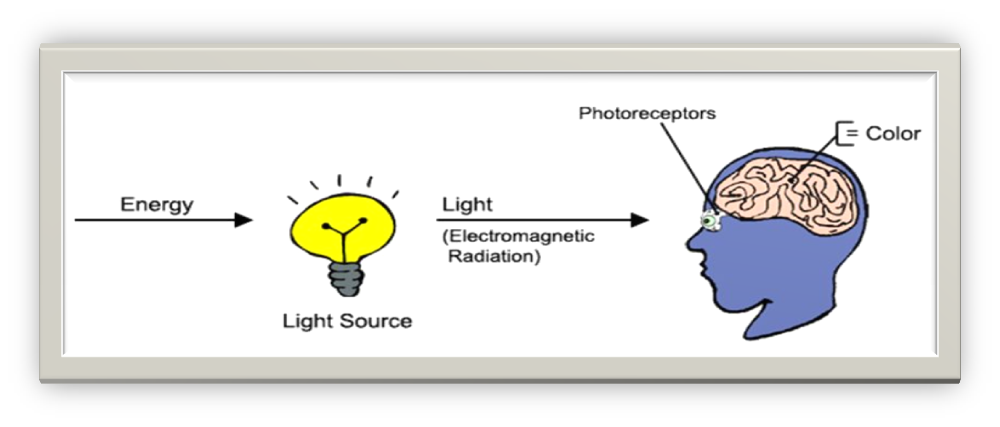
Laws of Reflection
- Books Name
- Class-8 Science Book
- Publication
- PathSet Publications
- Course
- CBSE Class 8
- Subject
- Science
Laws of Reflection
What happens when light falls on a mirror?
We know that light is a form of energy that is responsible for the sense of sight in the human eyes. Light can be called radiation that is emitted, reflected, or absorbed by different objects.
A mirror is a glass having a shiny surface. When light falls on a mirror it is reflected back. Hence a mirror changes the direction of light that falls upon it.
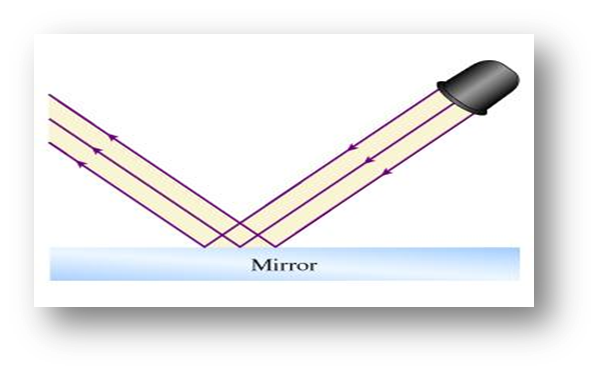
Reflection of Light: Bouncing back of light after striking a shiny or polished surface, in the same medium, is called reflection.
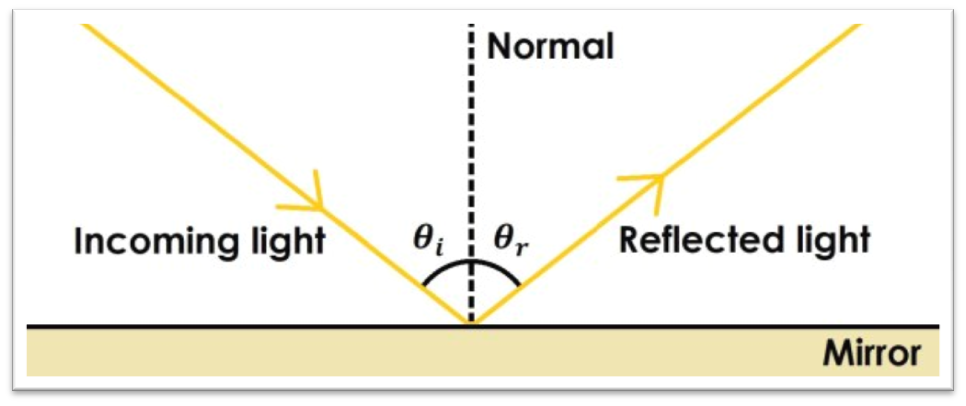
When light strikes a surface and bounces back, it is called reflection.
Incident ray - The ray of light that falls on the surface is called an incident ray.
Reflected ray - The ray of the light that gets reflected back from the surface is called a reflected ray.
Normal - It is an imaginary line that is drawn perpendicular to the reflecting surface at the point where the incident ray strikes the surface or at the point of incidence.
The angle of incidence (θi) - It is the angle that the incident ray makes with the normal.
The angle of reflection (θr) - It is the angle that the reflected ray makes with the normal.
First Law of Reflection
(i) ∠i (Angle of incidence) = ∠r (Angle of reflection)
The angle of incident is equal to the angle of reflection
The Second Law of Reflection
(ii) The incident ray, the normal at the point of incidence, and the reflected ray all lie in the same plane.
→ The laws of reflection are valid in regular as well as irregular or diffused reflections.
àThese laws of reflection are applicable to all types of reflecting surfaces including spherical surfaces.
Image formation by a Plane Mirror
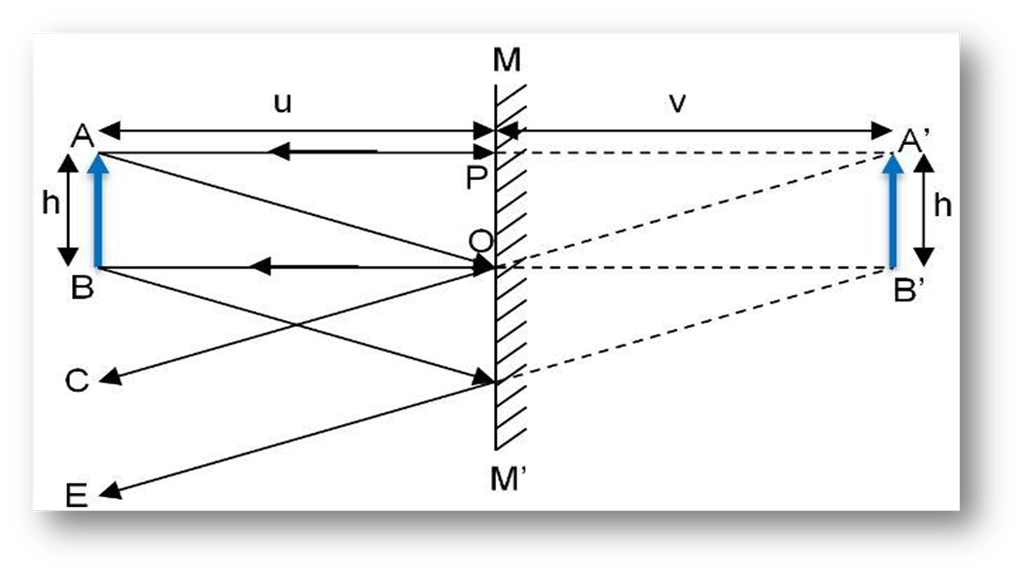
- Consider the figure given above. Here object AB of height ‘h’ is placed at a distance ‘u’ from the mirror.
- When the rays of light from this object fall on the mirror, the image of the object is formed inside the mirror.
- Consider the incident rays that fall on the mirror: AP, AO, and BO. These incident rays are reflected back from the mirror as PA, OC, and OB.
- The rays PA and OC are diverging rays hence we can extend them behind the mirror to find the point of intersection that is A’.
- Similarly, the other reflected rays are extended backward and virtual image A’B’ of height ‘h’ of the object AB is formed on the mirror.
- Characteristics of the image formed by a plane mirror are the following:
- It has the same height as that of the object.
- The distance between the image and the mirror and the object and the mirror is always equal.
- The image is erect or upright.
- The image is laterally inverted.
- It is a virtual image because it is formed by the apparent intersection of diverging rays.
Multiple Reflections
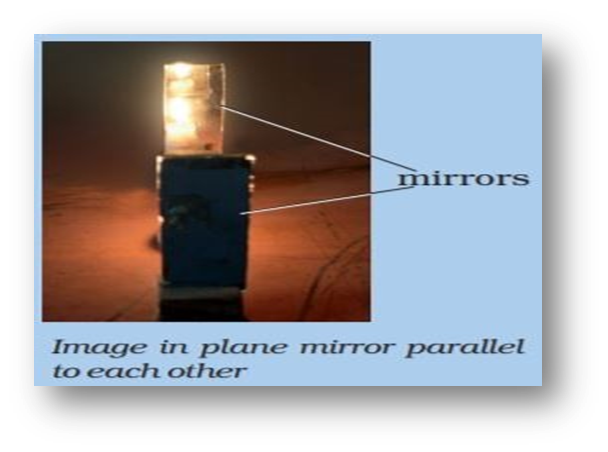
The image formed by a Plane Mirror is:
- of the same size as that of the object
- left-right inverted
- erect and virtual
- formed behind the mirror at the same distance as the distance of the object in front of the mirror
What is Lateral Inversion?
When an image is formed in a mirror, the left side of the object appears at the right side of the image and vice versa. This is called a lateral inversion.
Lateral inversion: Left part of the candle appears on the right and its right part appears on the left. This is known as lateral inversion.
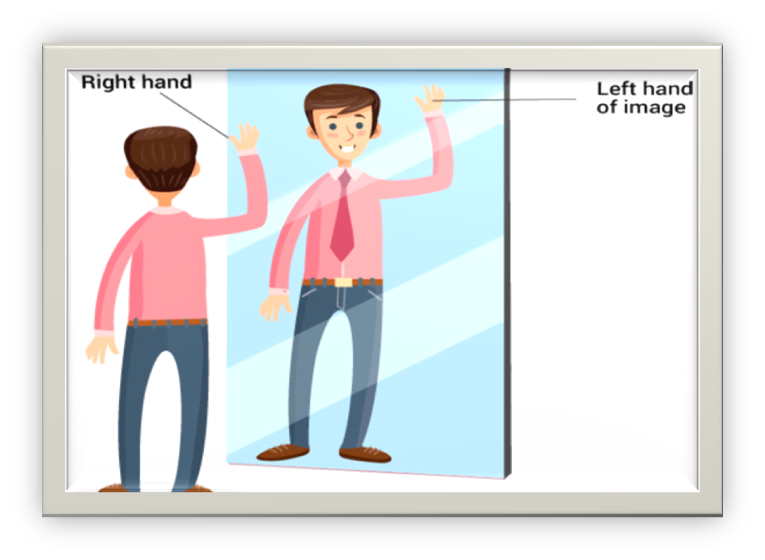
Luminous Objects - Objects which can produce light on their own are called luminous objects. Objects that are visible because of reflected light are known as illuminated objects, For example, tube light, bulb, the Sun, and the Stars.
Illuminated Objects - Objects that do not produce light on their own but reflect the light that falls upon them are called illuminated objects. Objects that give their own light are known as luminous objects. For example, the moon.
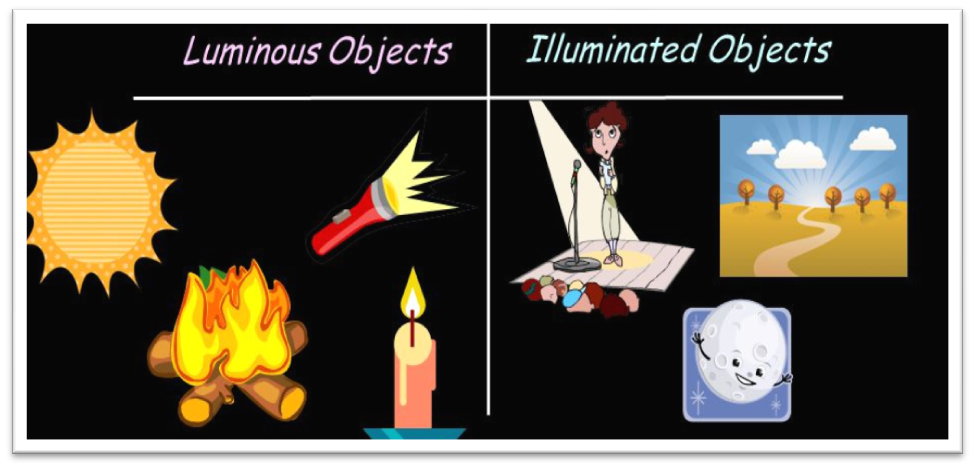
Regular and Diffused Reflection
- Books Name
- Class-8 Science Book
- Publication
- PathSet Publications
- Course
- CBSE Class 8
- Subject
- Science
Regular and Diffused Reflection
Types of Reflections
There are two types of reflection:
REGULAR AND DIFFUSED REFLECTION
(i) Regular Reflection: When the reflection surface is smooth and well–polished, the parallel rays falling on it are parallel to another one, the reflected light goes in one particular direction and also parallel to each other. This is regular reflection. E.g. plane mirror, reflection from still water. Reflection from a smooth surface like that of a mirror is called regular reflection. Smooth or polished surfaces give regular reflection.
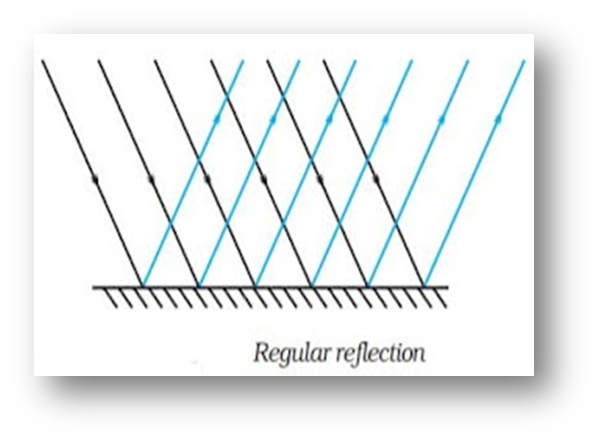
(ii) Diffused and Irregular Reflection: When the reflecting surface is rough, the parallel rays falling on it are reflected in a different direction. Such reflection is known as diffused or irregular reflection. Example- Reflection of light from the wall of the room. When all the parallel rays reflected from a plane surface are not parallel, the reflection is known as diffused or irregular reflection. Uneven unpolished surfaces give irregular reflection.
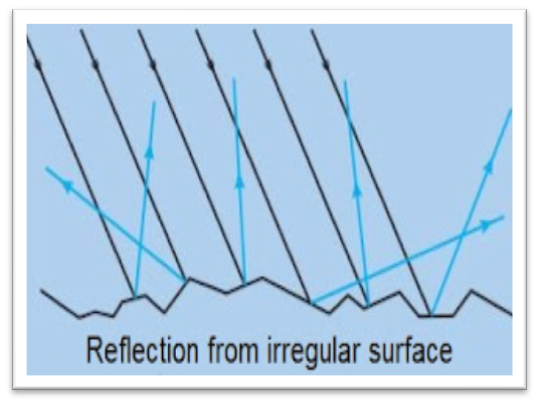
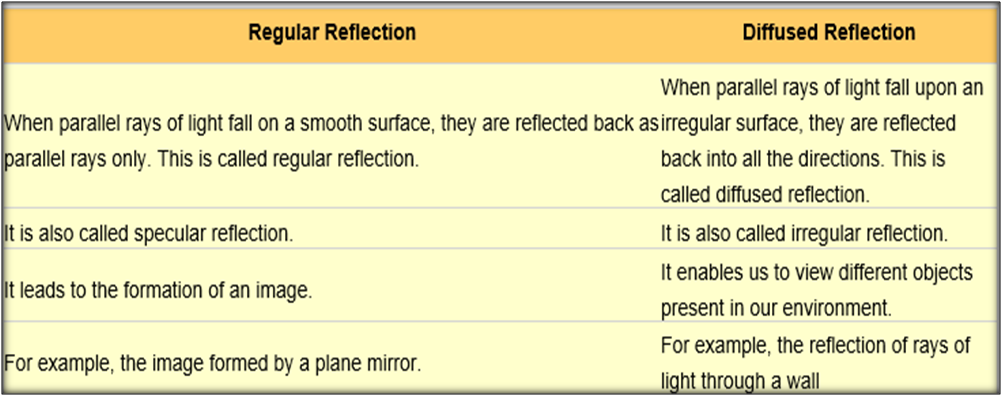
Reflected Light Can be Reflected Again
- Books Name
- Class-8 Science Book
- Publication
- PathSet Publications
- Course
- CBSE Class 8
- Subject
- Science
Reflected Light can be Reflected again
Multiple reflections can be obtained by placing more than one mirrors at certain angles to each other which results in reflection of light for multiple times between the reflecting surfaces. This phenomenon is used in certain scenarios such as:
- In a Periscope to see hidden objects
- In a kaleidoscope to see beautiful patterns
- In a barbershop to see the back of the head of a person getting a haircut
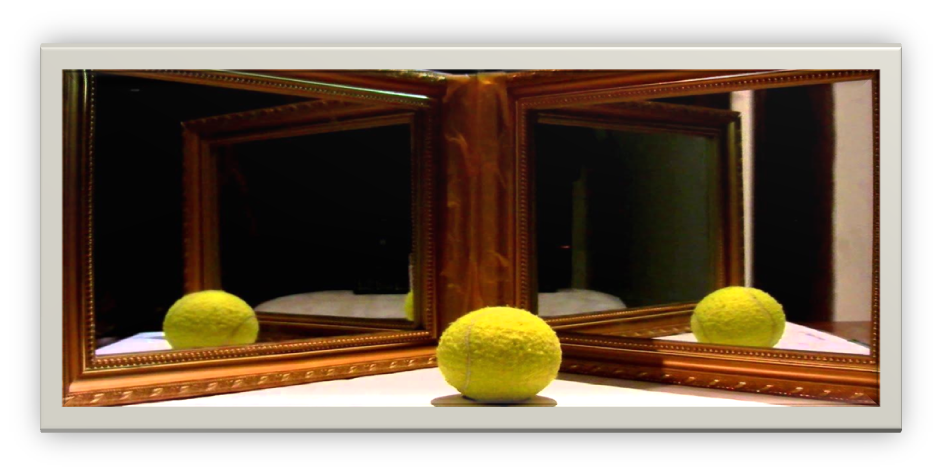
Multiple Images
- Books Name
- Class-8 Science Book
- Publication
- PathSet Publications
- Course
- CBSE Class 8
- Subject
- Science
Multiple Images
- When two or more mirrors are placed at some angle to one another, multiple images of an object is formed.
- For example- the hairdresser shop has two mirrors placed opposite to each other. If a man is sitting between them, His image is formed in both the mirrors. This will give result in the formation of multiple images.
- The number of images formed depends on the angle between the two mirrors.
- If the given two mirrors are at a right angle to each other, 3 images will be obtained. If the given mirrors are at 60° angle, we shall get 5 images.
- When the two mirrors are kept opposite and parallel to each other, we will get an infinite number of images formed.
What is a Periscope?
- A Periscope is an instrument that is used to look at objects that are not in the line of sight of the observer.
- In other words, it is used to see objects that are hidden.
- The Periscope works on the phenomena of multiple reflections of light.
- Inside the periscope, there are two mirrors that are inclined at an angle of 45
- Periscopes are generally used in submarines, tanks and bunkers by the soldiers.
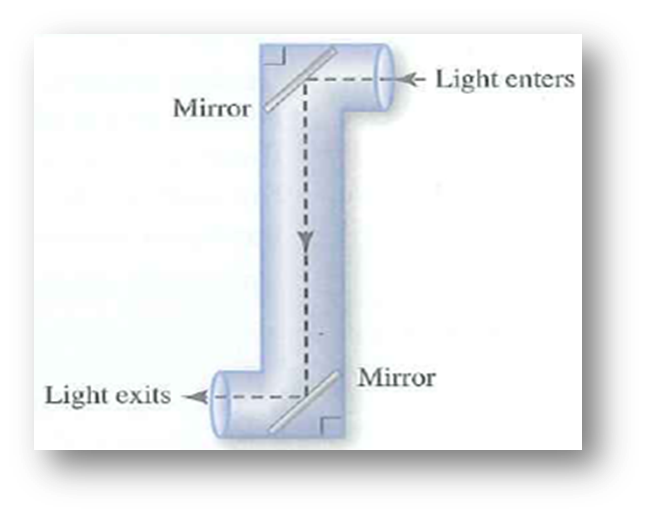
What is a Kaleidoscope?
KALEIDOSCOPE -The idea of a number of images formed by mirrors placed at an angle to one another is used in a kaleidoscope to make numerous beautiful patterns.
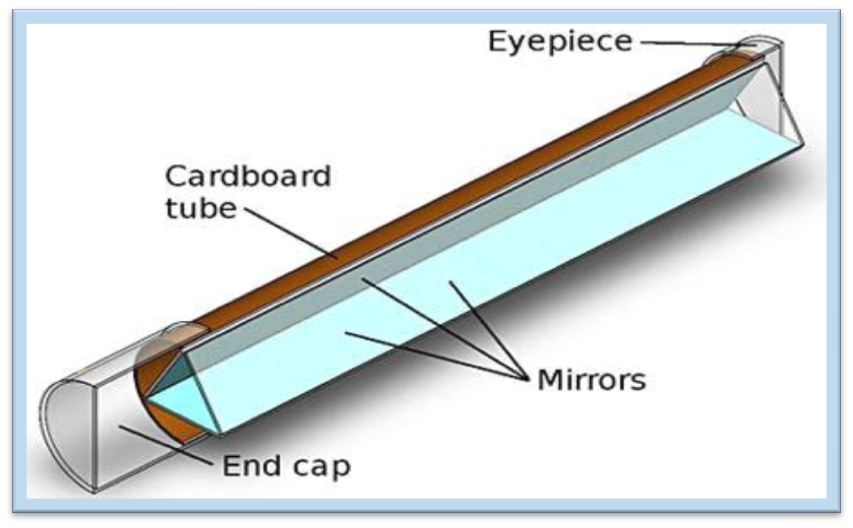
- It is a device that works on the phenomena of multiple reflections with the help of multiple mirrors.
- It has a cylindrical structure with three plane mirrors inside it.
- It contains several pieces of beads, broken glass, colourful bangles, pebbles, etc.
- The observer can look into the Kaleidoscope from one end and the light enters into the Kaleidoscope from the other end.
- When the light falls upon these objects in the Kaleidoscope, multiple reflections of these objects are created in the three Mirrors.
- This results in the formation of beautiful and colourful patterns.
- Since the reflection of light is not always the same the observer never sees a similar pattern in the kaleidoscope.
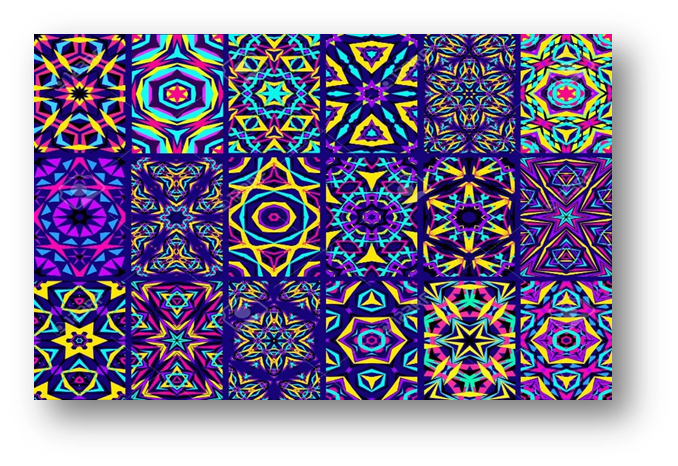
Sunlight – White or Coloured
- Books Name
- Class-8 Science Book
- Publication
- PathSet Publications
- Course
- CBSE Class 8
- Subject
- Science
Sunlight - white or coloured
- The sun is the biggest source of light on the earth.
- The sunlight is white in colour however this white light often disperses into several colours which results in different colours of the sky at different times of the day.
- The white light consists of seven colours namely VIBGYOR (violet, indigo, blue, green, yellow, orange and red).
- This arrangement of seven colours of white light is called Spectrum.
- All these colours mixed together and form the white light. However, due to the reflection of light, the seven colours can split and be seen as separate colours rather than a single white light.
- This phenomenon of the splitting of light into its constituents is called Dispersion of light.
Examples of Dispersion of Light:
- Formation of the rainbow due to the dispersion of white light through the water droplets.
- Passing of Sunlight through a prism
- Dispersion of light through the soap Bubbles
- Dispersion of light on the CDs
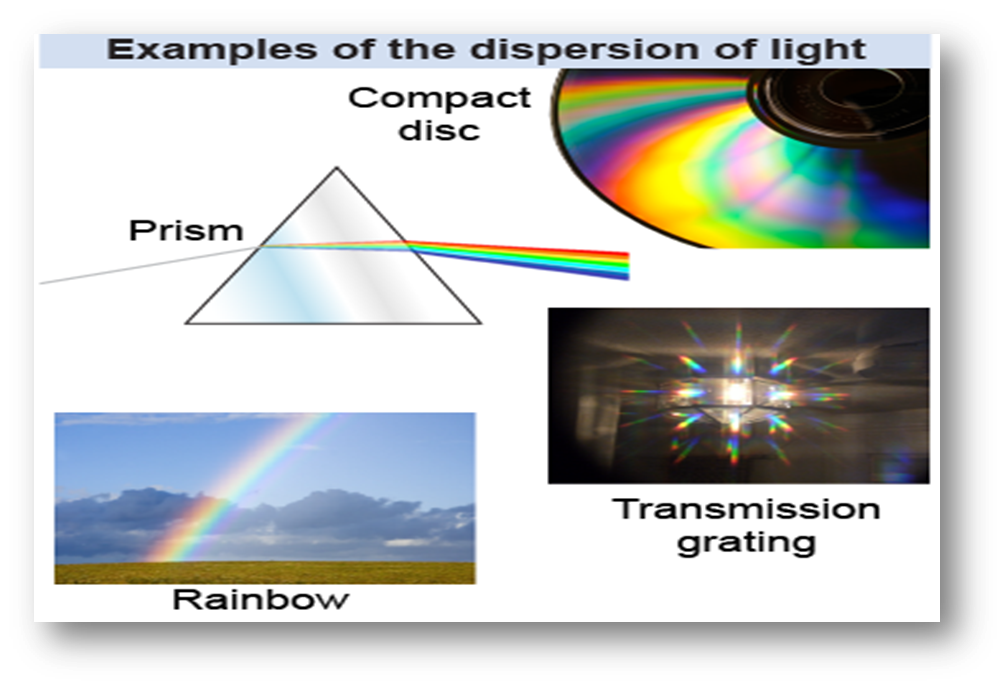
What is inside Our Eyes?
- Books Name
- Class-8 Science Book
- Publication
- PathSet Publications
- Course
- CBSE Class 8
- Subject
- Science
What is inside our Eyes?
The structure and working of the Human Eye
- Eyes are sensory organs that allow us to see things present in the environment.
- The eyes absorb the light rays and form a visual image and transform this information of the image to the brain.
- The eye has a spherical structure which is called the eyeballs. The eyeballs are attached in the eye socket and various muscles are connected to them called the eye muscles. These are muscles allow the movement of the eyeballs.
- The eyes are protected with eyelids. They prevent an excess of light and dust to enter the eyes and therefore save the eyes from any outer objects.
The Parts of the Human Eye
- Cornea - It is a transparent covering present on the outer side of the eyes. It consists of 6 layers. Tear fluid covers the cornea and protects the eye.
- Iris - It is a dark-coloured muscular structure present in the center of the cornea. The Iris consists of a small opening called Pupil through which the light enters into the eye. The Iris has colourful pigments like grey, blue, black, green, brown, etc. The amount of light that enters the eye is controlled by the Iris. In other words, Iris controls the Pupil.
- Lens - It is like a sphere of liquid present inside the eye. The eye lens is located behind the Pupil which helps in the formation of an image in the eye.
- Retina- Retina is a layer located behind the lens at the back of the eye. The eye lens focuses the light that enters the eye over the retina. The retina consists of different Nerve cells that perform different tasks. There are sensory cells that detect light. They then transform that information into an electrical impulse. These electrical impulses are sent to the brain via the optic nerve. Two types of vision cells in the retina are:
- Rods or chopsticks - They get activated in darkness or dim light and the responsible for light-dark vision.
- Cones - they react to bright light and therefore sense colour in an object.
- Vitreous Chamber - The inner space of the eyeball called the transparent vitreous chamber consists of a gel-like substance. This substance maintains the right pressure in the eye and maintains the stability of the eyeball.
- Blindspot - There is a point in the eye located at the junction of the retina and the optic nerve where no sensory cells are present. This spot is therefore called the blind spot as it does not support any vision.
Persistence of image on the retina
- The image that is formed on the retina persists for 1/16th of a second.
- Therefore, if one tries to move 16 still images per second of a moving object in front of our eye it appears as if the object is moving. This is how animation films and movies work. They are a collection of separate pictures which are moved in a sequence.
- However, this movement is so fast, around 24 pictures in a second, that it appears as if they are moving.
The vision may decrease with age
- Normally a person can see distant and nearby objects through the eyes.
- A person with normal eyes can read most comfortably at a distance of 25cm. However, this distance can decrease with age.
- Also sometimes people can see far objects clearly but not the objects that are nearby (farsightedness or hyperopia).
- Similarly, some people can see the nearby objects clearly but not the far objects (nearsightedness or myopia). Hence they use suitable lenses to correct such defects.
- Sometimes with old age, the lens of the eye can become cloudy or foggy. This condition is called cataract with results in loss of vision.
- However, this defect can be rectified by removing the old lens from the eye and inserting an artificial lens at that place.
VISION DEFECTS
some of the defects are -
- Myopia: A person with myopia can see near objects clearly while distant objects appear blurred. This disease is also called short-sightedness or near-sightedness. Spectacles with concave lenses can improve the vision of a myopic person.
- Hypermetropia: A person with Hypermetropia can see distant objects clearly but cannot see nearby objects distinctly. This disease is also called long-sightedness. Spectacles with convex lenses can improve the vision in a hypermetropic person.
- Cataract: During old age, the crystalline lens becomes milky and cloudy in a cataract patient and thus the person cannot see clearly. A cataract is treated by surgery. In cataract surgery, the cloudy lens is removed and an artificial lens is transplanted in the eye.
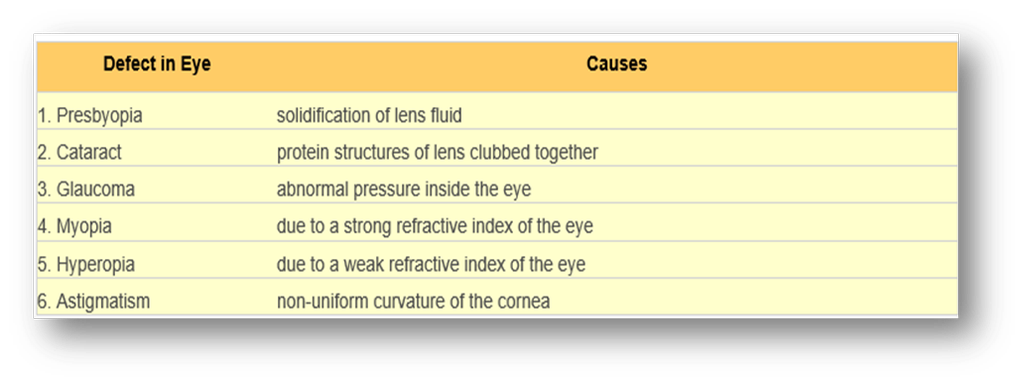
Care of the Eyes
- Books Name
- Class-8 Science Book
- Publication
- PathSet Publications
- Course
- CBSE Class 8
- Subject
- Science
Care of the Eyes
How to take care of the eyes?
- One should go for a regular eye check-up.
- Wear spectacles if the eyesight is found weak.
- Always study or watch TV in sufficient light. Excess or insufficient light can lead to problems. Insufficient light can cause strain and leads to a headache.
- Do not look at the sharp source of light like the sun directly. Excess of light can damage the eyes.
- If dust enters into the eye one should not rub them and rather wash them straight away.
- Maintain a normal distance while reading or watching TV.
- Take a balanced diet to ensure that you get the right nutrients.
What Is Night Blindness?
Night blindness also called nyctalopia is a defect in the vision in which people cannot view things properly in dim light or at night. It mainly occurs due to the lack of vitamin A in our body. Hence we should always take foods that are rich in vitamin A such as broccoli, green vegetables, carrot, milk, eggs, curd, papaya, mango, etc.
Visually Impaired Persons Can Read and Write
- Books Name
- Class-8 Science Book
- Publication
- PathSet Publications
- Course
- CBSE Class 8
- Subject
- Science
Visually Impaired Persons can Read and Write
VISUALLY CHALLENGED PERSON
- Some persons, including children, can be visually handicapped. They have very limited vision to see things. Such persons are called visually challenged persons.
- A visually challenged person usually develops their other senses more sharply- like the sense of hearing and sense of touch.
- However, additional resources can enable them to develop their capabilities further. Resources can be of two types: Non-optical aids and optical aids.
- Optical Aids: Optical aids help a person who is partially visually challenged. These aids enlarge an image or a text so that they could be visible. Bifocal lenses, contact lenses, tinted lenses, magnifiers and telescopic aids, magnifying devices and telescopic devices come under this category.
- Non-optical Aids: Non-optical aids help a person who is completely visually challenged. Non-optical aids include visual aids (magnify words), tactual aids (using the sense of touch), auditory aids (using the sense of hearing) and electronic aids.
How can visually impaired people read and write?
- Visual impairment is also known as vision loss.
- A person with vision loss cannot see at all.
- This loss of vision is up to a degree that cannot be corrected using usual means like using glasses or lenses.
- The people who have no eyesight at all develop the other senses of listening and touching sharply which allows them to do their day-to-day activities.
- However, there are certain resources that have been developed to help such people:
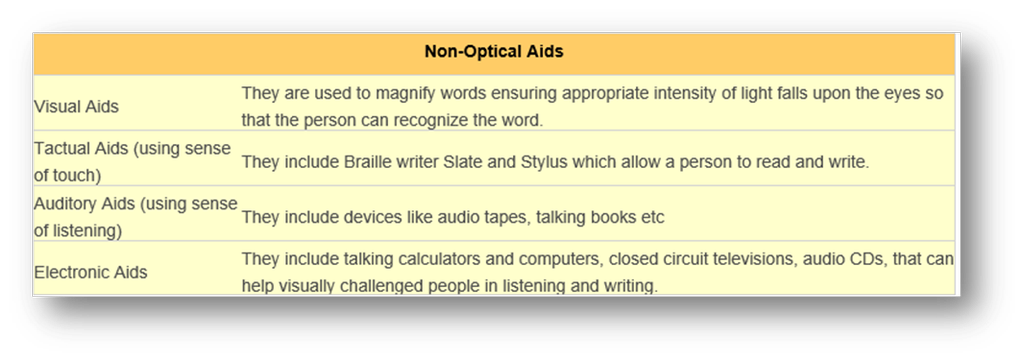
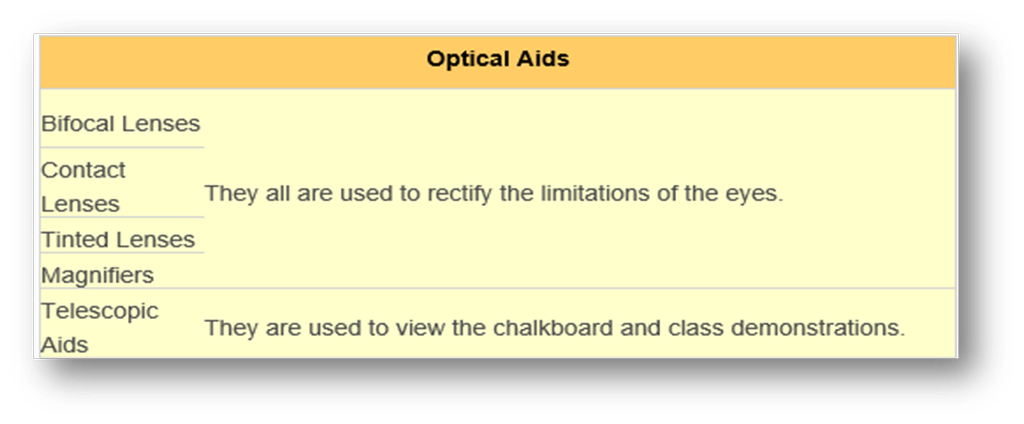
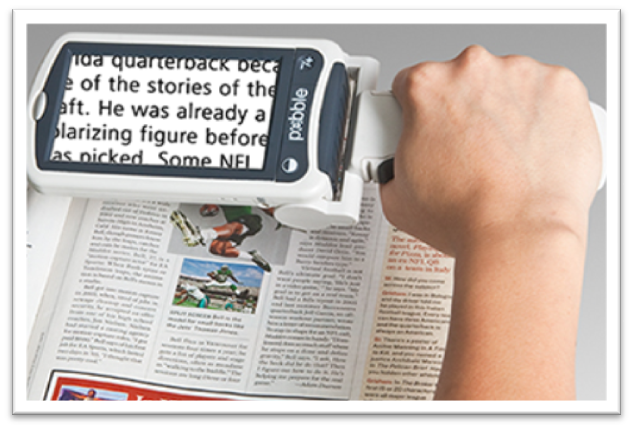
What is Braille System?
- Books Name
- Class-8 Science Book
- Publication
- PathSet Publications
- Course
- CBSE Class 8
- Subject
- Science
What is Braille System?
The Braille system
- Braille is a tactual aid for visually challenged people that allow them to read and write.
- It was developed by a visually challenged person called Louis Braille. This system was published by him in 1821 however the present Braille System was adopted in 1932.
- For many common languages including Hindi, Sanskrit, Tamil, Telugu, Mathematics and scientific notations a Braille code is present.
- In the Braille code, there are 63 Dots or 63 Characters.
- These are arranged in a cell of two vertical rows having three dots each.
- The patterns are embossed on a Braille Sheet that allows a person to read by touching the pattern. Each character in the Braille system can represent:
- a letter
- a combination of letters or a word
- a grammatical sign

The eyes of animals have different shapes
- Crab: Crabs have small eyes but they can look all around with them even behind them.
- Butterflies: Butterflies have big eyes that consist of thousands of small eyes which allow them to see in the front and at the back.
- Night owls (Night Birds): Night owls are able to see things more clearly at the night rather than in day time. This is so because the cornea of their eyes is large with a large pupil which allows light to enter into the eye at night time. However, their eyes have a large number of rod cells rather than cones that allow them to see things at night easily.
- Kites and Eagles (Day Birds): These birds can see very well during the daytime but have decreased vision at night. This is because they have a large number of cone cells and a few rod cells.

 PathSet Publications
PathSet Publications
